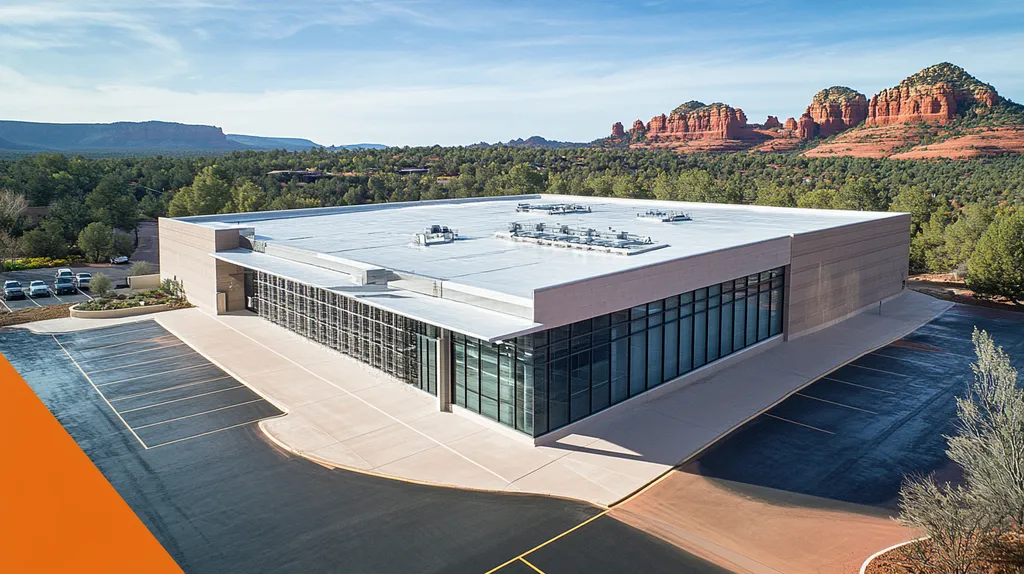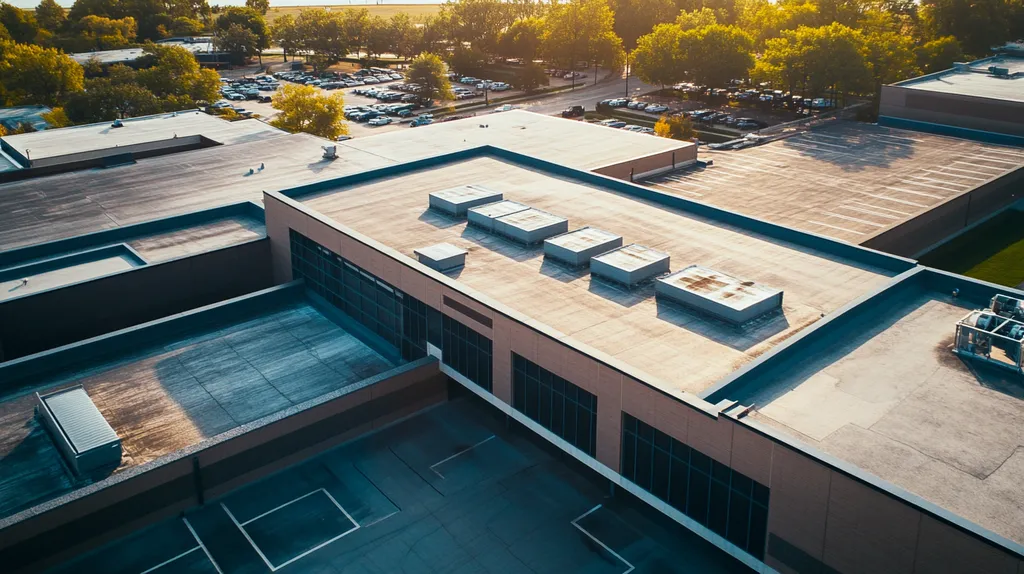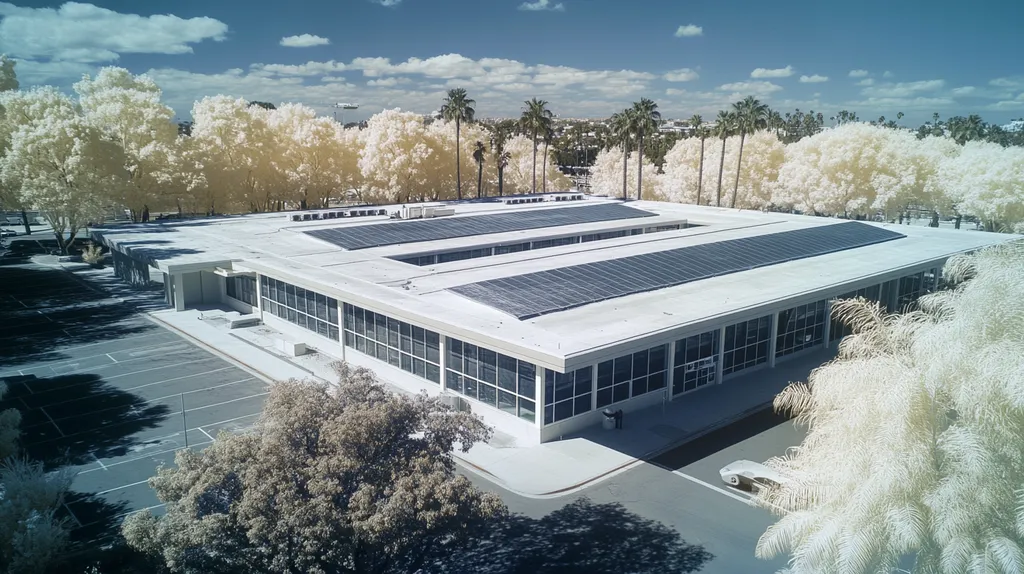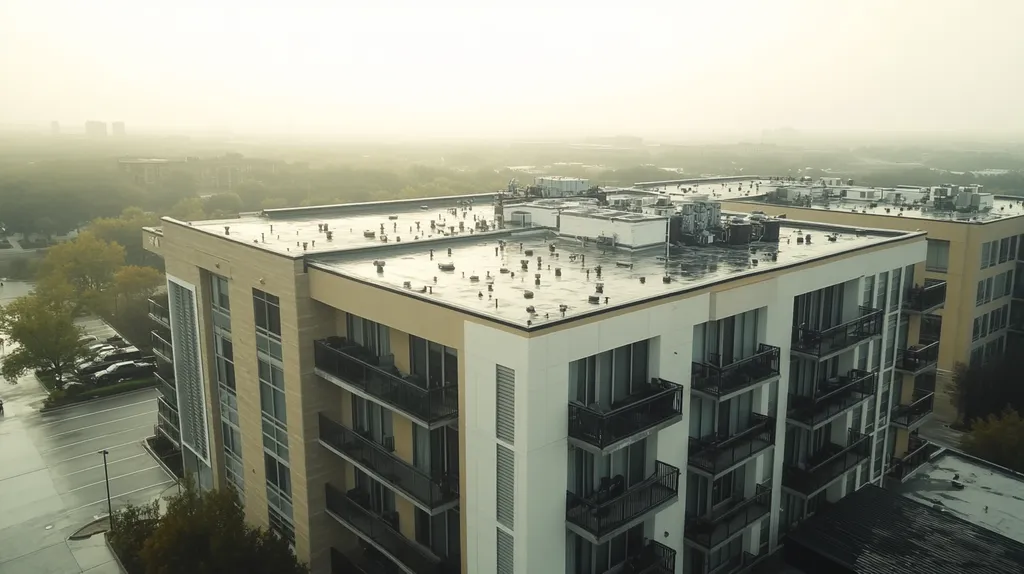Commercial roofing certification standards are failing property owners at an alarming rate, with studies showing that 40% of roof failures stem directly from inadequate contractor qualifications.
Despite billions invested annually in commercial roofing, current certification practices remain fragmented and inconsistent, leaving building owners vulnerable to subpar installations and premature system failures.
This analysis examines how established certification processes fall short, explores the systemic issues behind these failures, and proposes data-driven solutions to protect valuable commercial assets through enhanced contractor qualifications.
SECTION 1: CURRENT PRACTICES
The commercial roofing industry is at a critical juncture. With research indicating that nearly 50% of commercial roofs underperform due to inadequate installation, property owners and facility managers face considerable risks. This section dives into the current certification processes and examines the influential roles played by industry associations and manufacturers. Understanding these factors is essential for making informed choices that protect both investments and assets.
Certification Processes and Requirements
Contractors pursuing certification often find themselves navigating a landscape of varying training programs. While many of these programs cover fundamental installation techniques and safety protocols, they frequently overlook critical elements vital to roofing systems. This unevenness in certification processes can lead to significant gaps in contractor proficiency.
For example, a contractor might receive certification after attending a brief seminar hosted by a manufacturer, yet this does not guarantee they have the hands-on experience essential for managing intricate roofing projects. Such gaps in training can result in costly oversights during installation, impacting the longevity of the roof.
Although some manufacturers provide thorough training programs, the overall certification approach remains disjointed. This lack of standardization raises doubts about the credibility of certifications and their true reflection of a contractor’s expertise.
Property owners must evaluate not only the certification itself but also the depth and context of the training involved. A clear understanding of the specifics of each certification can significantly enhance decision-making and safeguard investments.
Role of Industry Associations and Manufacturers
Industry associations and manufacturers serve as key architects of standards and certifications within the roofing sector. Many associations strive to establish best practices and create valuable educational resources for contractors, yet their effectiveness can vary dramatically.
Some associations emphasize rigorous standards, advocating for ongoing education and practical skills assessments to ensure contractor competence. Others may offer certifications that require little more than a fee and attendance, undermining the value of those credentials.
This quality disparity often leads to confusion among property owners. With a multitude of certifications available, distinguishing credible ones can be challenging. It’s common for property owners to mistakenly equate an association membership with guaranteed contractor skill.
Therefore, conducting thorough research into the prestige and requirements of these associations is imperative. Understanding which organizations maintain high standards can greatly assist property owners in their contractor selection process.
Licensing vs. Certification Distinctions
In the roofing industry, understanding the differences between licensing and certification is crucial but often misunderstood. Licensing ensures that contractors comply with local or state regulations, focusing on basic safety and competency. It represents the minimum requirement for legal operation.
In contrast, certification typically highlights a contractor’s specialized knowledge or advanced proficiency in particular roofing systems. However, because certification lacks consistent regulation, not all certified contractors possess the skills necessary for complex projects.
Ultimately, grasping these distinctions empowers property owners to ask critical questions and seek out contractors who are not only licensed but also demonstrate substantial competencies through reputable certifications.
SECTION 2: SYSTEMIC ISSUES
In the fast-evolving world of commercial roofing, systemic issues pose significant challenges that erode the trustworthiness of contractor certifications. Many property owners remain in the dark about the alarming variability in quality standards among different certifying bodies. This inconsistency can lead to incorrect roofing choices, resulting in expensive repairs and irreversible damage. A critical reassessment of the certification process is essential to ensure that all contractors meet robust and uniform standards. The following issues highlight the current shortcomings within the certification landscape.
Inconsistent Quality Standards
Quality standards in commercial roofing certifications are far from uniform. Some programs involve rigorous assessments and testing, while others provide minimal checks on qualifications. This disparity presents a substantial risk to property owners.
Consider a scenario where a contractor receives certification from a program with lax requirements. The result could be a lack of attention to detail during installation, leading to leaks and increased maintenance expenses down the line. This situation emphasizes the necessity for property owners to closely examine certification programs and select those that uphold consistent quality standards.
Without clearly defined evaluations, facility managers face difficulty in making informed decisions. Identifying which certifications ensure superior quality is critical for avoiding future roofing problems. Establishing a unified set of quality standards across the industry could substantially decrease financial risks for building owners.
Limited Scope of Certifications
A significant limitation of current roofing certifications is their narrow focus, primarily concentrating on installation techniques or specific materials. This restricted view fails to address other vital aspects of roofing, such as long-term maintenance and overall system performance.
For instance, a contractor might be proficient in installing a specific membrane but lack training in essential elements like drainage design or material longevity. These oversights can result in catastrophic failures down the line, leaving property owners vulnerable.
Many property owners wrongly assume that certification automatically guarantees comprehensive expertise, which is not necessarily true. Relying solely on these limited certifications can create weaknesses that remain undetected until serious damage occurs. Advocating for broader certification that encompasses various roofing aspects would enhance property owners’ trust in their contractors’ competencies.
Regulatory and Compliance Gaps
The regulatory framework surrounding commercial roofing is riddled with gaps that undermine the credibility of certifications. In many regions, there are insufficient regulations governing roofing practices, leading to inconsistencies in compliance and oversight.
For example, in some jurisdictions, roofing contractors are not required to hold any license, opening the door for unqualified individuals to work on commercial projects. This poses a significant risk for property owners, who invest substantial resources into their roofing systems.
The lack of cohesive regulations allows uncertified contractors to operate alongside reputable professionals, further cluttering the landscape. Property owners often struggle to discern credible contractors amid this confusion.
To safeguard their investments, property owners should advocate for stricter regulations and improved compliance in the roofing sector. Pressing for policy changes could play a vital role in elevating the overall quality of roofing services in the industry.
SECTION 3: MISSED OPPORTUNITIES
The commercial roofing industry is missing out on critical opportunities that could drastically improve the lifespan and effectiveness of roofs. Property owners frequently overlook cutting-edge technologies that could enhance both installation and ongoing maintenance. Recent research shows that roofs installed with innovative methods can last up to 30% longer than those done using traditional techniques. By not embracing these advancements, buildings may encounter significantly higher lifecycle costs and diminished energy savings.
Overlooking Advanced Technologies
Many contractors remain rooted in traditional methods, ignoring advanced technologies that can offer remarkable advantages. For example, drone inspections deliver faster and more precise identification of roofing issues compared to manual checks. Drones also enhance safety by reducing the need for risky ladder usage.
Furthermore, infrared thermography allows for accurate detection of moisture trapped within roofing systems. This proactive approach can avert expensive repairs and significantly enhance the durability of roofs. Despite these benefits, not enough contractors are willing to integrate these innovations into their practices.
As technological advancements continue to reshape the industry, facility managers must prioritize contractors who effectively incorporate these modern tools. Overlooking this can lead to underperforming roofs that escalate operational costs and threaten overall building integrity.
Ultimately, property owners should insist on contractors who are proficient in employing contemporary technologies to assure effective roofing solutions that stand the test of time.
Neglecting Continuous Training Needs
The roofing industry is ever-changing, yet numerous contractors overlook the importance of ongoing training. With new products, installation techniques, and safety protocols continuously emerging, regular education is crucial. Without it, contractors may rely on outdated methods that jeopardize roof performance and safety.
For instance, many contractors are unaware of the latest safety regulations related to roofing materials. This knowledge gap can lead to compliance issues, exposing property owners to potential legal repercussions. It’s essential for contractors to engage in workshops and continuous education to stay current.
Facility managers should seek out contractors who are committed to lifelong learning. This ensures that roofs are installed correctly and maintained according to the most up-to-date standards. The long-term advantages of partnering with well-trained contractors far outweigh the risks associated with outdated practices.
By emphasizing the necessity of ongoing training for all roofing professionals, property owners can significantly enhance overall building performance.
Failure to Address Emerging Materials
The roofing landscape is advancing towards new materials that promise increased durability and sustainability. However, many contractors cling to traditional options, missing the chance to take advantage of more effective alternatives. New materials such as TPO and PVC offer superior energy efficiency and reflectivity, which can lower cooling costs for commercial properties.
Using these modern materials can also support green building initiatives. As the demand for sustainable roofing solutions rises, contractors must stay informed about these innovations. Neglecting to embrace new materials could jeopardize the long-term viability and performance of roofing systems.
To lead efficiently in the market, property owners need to proactively choose contractors who are knowledgeable about these innovative materials. By championing sustainable options, they can reduce operational costs while enhancing environmental responsibility.
In summary, addressing the neglect of emerging materials can secure competitive advantages for contractors while providing enhanced benefits for property owners.
SECTION 4: ROOT CAUSES
The commercial roofing industry is at a defining moment. A staggering 60% of commercial buildings experience roofing failures due to poor workmanship and lack of standardization. This alarming statistic underscores the urgent need for effective contractor certifications. Without clear, uniform national standards, property owners are left exposed to mediocre practices and potential liabilities. Understanding the root causes of this chaos is essential for making informed choices and fostering a healthier industry.
Lack of Uniform National Standards
The absence of a single set of national standards for commercial roofing contractors is a significant challenge. Each state has its own requirements, leading to inconsistencies that confuse property owners. This fragmentation allows the meaning of “certified” to vary widely, which complicates the decision-making process for business managers.
Moreover, varying levels of contractor expertise emerge from this lack of uniformity. Some contractors adhere to rigorous protocols, while others may cut corners due to looser requirements. Without a reliable benchmark, property owners find it difficult to identify truly qualified professionals, paving the way for subpar work.
This inconsistency can have dire consequences. Substandard roofing not only impairs safety and performance but can also lead to significant long-term damage and escalating repair costs. Establishing cohesive standards is critical to ensuring quality and safety across all commercial roofing projects.
Moving towards a standardized certification process could foster trust and accountability within the industry, enabling property owners to make informed choices. Developing uniform standards isn’t merely a suggestion; it’s a necessity for protecting investments.
Insufficient Enforcement Mechanisms
Even when standards do exist, inadequate enforcement mechanisms breed widespread non-compliance. Regulatory bodies often lack the necessary resources to effectively monitor contractor practices, allowing unqualified individuals to operate without oversight, which jeopardizes property owners’ investments.
Additionally, inspections intended to validate compliance can sometimes be superficial. Properties might pass inspections even while harboring serious issues. This ineffective vetting process fails to offer the protection that building owners deserve when hiring contractors.
The consequences are far-reaching. Poorly installed roofs can lead to leaks, structural damage, and ultimately costly repairs. Without strict enforcement of even the current regulations, the roofing industry remains a precarious landscape for property owners navigating project decisions.
Addressing these enforcement gaps could significantly enhance the situation. Instituting rigorous checks and balances would elevate industry standards and instill confidence among property owners investing in commercial roofing.
Inadequate Public Awareness
A significant hurdle arises from the fact that many property owners lack a fundamental understanding of what constitutes a quality roofing job or contractor. This knowledge gap exacerbates the problem, as property owners struggle to vet contractors effectively. Misinterpretations about certifications can lead to poor decision-making, ultimately costing them more.
Add to this the misleading impressions created by marketing campaigns from subcontractors. Often, without a clear grasp of necessary certifications, property owners may unwittingly fall victim to deceptive practices.
Therefore, public awareness campaigns highlighting the importance of contractor certifications are crucial. Educating property owners about what to expect from a quality roofing project can empower them to make informed decisions. This proactive approach could substantially reduce instances of substandard work.
When property owners become informed, they are better equipped to demand more from roofing contractors. Informed clients foster a stronger industry where quality and professionalism become expected standards rather than happy exceptions.
DATA DRIVEN EVIDENCE
As the stakes rise for commercial property owners facing aging roofs and increasingly severe weather events, understanding the value of contractor certifications becomes crucial. Studies indicate that buildings serviced by certified roofing contractors suffer 25% fewer leaks than those relying on non-certified workers. This section explores compelling statistical analyses, insightful case studies, and comprehensive industry surveys to highlight the tangible benefits of hiring certified roofing professionals.
Statistical Analysis of Certification Impact
Statistical data reveals a profound connection between contractor certifications and the longevity of roofing systems. Research indicates that certified roofers yield an impressive 85% satisfaction rate among property owners, while their non-certified counterparts lag behind with only 60% satisfaction.
Moreover, roofs installed by certified contractors experience a failure rate of less than 5% within the first five years, in stark contrast to over 15% for roofs installed by non-certified workers. These figures starkly underscore the significant role that certification plays in enhancing roofing durability and performance.
Additionally, insurance companies observe lower claim rates for buildings with certified installations. This trend highlights the financial advantages of engaging certified contractors, as infrequent repairs translate directly to cost savings for property owners.
For property managers making roofing decisions, these statistics reinforce the importance of prioritizing contractor certifications. Investing in certified professionals not only ensures peace of mind but also delivers long-term savings and bolstered building integrity.
Case Studies of Certified vs. Non-Certified Contractors
Diving into specific case studies sheds light on the stark differences in outcomes between certified and non-certified roofing contractors. For instance, a commercial complex that engaged a certified professional reported significantly fewer maintenance issues and implemented retrofits that exceeded industry standards.
In contrast, a nearby facility that opted for a non-certified contractor faced chronic ponding issues and deteriorating materials just two years after installation. These discrepancies not only affected the properties’ visual appeal but also led to skyrocketing repair costs that strained the facility’s finances.
Another notable case in a harsher climate illustrated a certified firm’s use of advanced materials and techniques, resulting in a roof that remained intact despite severe hailstorms. This resilience underscores the essential role of expertise and continual education in roofing practices.
Such case studies clearly demonstrate that certified contractors provide superior workmanship. They emphasize that selecting a qualified contractor is not merely a preference, but an absolute necessity for ensuring long-term building health and financial stability.
Industry Surveys and Feedback
Recent surveys among facility managers reveal a strong inclination towards contractor certifications, with approximately 78% of respondents stating they would only consider certified contractors for roofing projects. This response reflects a growing demand for quality assurance linked to certifications within the industry.
Moreover, feedback from those who hired certified contractors typically praises the professionalism and reliability associated with their work. In contrast, experiences with non-certified contractors often highlight poor communication and inconsistent workmanship quality.
The insights garnered from these surveys illustrate a broader industry trend where certifications are increasingly recognized as essential for not only enhancing roofing quality but also improving overall project management. As property owners voice their preferences, understanding this feedback will be vital for making informed choices.
The reliance on survey data marks a fundamental shift in the industry, signaling that certifications are no longer just a formality, but a critical factor in achieving optimal roofing performance and greater owner satisfaction.
SECTION 6: ALTERNATIVE SOLUTIONS
The roofing industry stands at a pivotal crossroads, wrestling with outdated certification processes that fail to ensure consistent quality. Alarmingly, a recent study reveals that nearly 30% of commercial roofing projects suffer significant failures due to inadequate installation practices. This not only jeopardizes the integrity of the roofs but also leads to substantial financial strain for property owners. A reevaluation of existing certification methods could elevate industry standards and protect valuable investments. This section discusses the critical need for unified certification standards, advanced training programs, and enhanced public awareness as key solutions.
Implementing Unified Certification Standards
Adopting unified certification standards can substantially boost the reliability of roofing contractors. At present, a patchwork of organizations provides certifications, causing confusion and inconsistency in quality. For instance, a contractor certified by one organization might not fulfill the expectations set by another.
By establishing a standardized certification process industry-wide, property owners can anticipate more consistent quality and performance. This could involve the creation of a centralized authority responsible for overseeing training and certification protocols.
Additionally, unified standards can mitigate the presence of rogue contractors who exploit regulatory gaps. When all contractors are held to the same criteria, it enhances the overall standard of work across the industry.
Moreover, a single certification system can simplify communication between property owners and contractors, reducing uncertainty and risk. Improved transparency regarding qualifications empowers property owners to make well-informed decisions.
Integrating Advanced Training Programs
Advanced training programs are essential for equipping contractors with the latest roofing technologies and installation methods. As the industry progresses, traditional training often fails to keep pace with innovations in materials and techniques.
Consider, for example, the rise of energy-efficient roofing solutions that necessitate knowledge beyond conventional practices. By incorporating comprehensive training modules, contractors can remain informed about advancements, resulting in superior installations.
Advanced training programs can also address specialized topics such as sustainable roofing and emergency repair strategies. As contractors enhance their skill sets, property owners can feel more confident about the quality of service delivered.
Additionally, fostering partnerships with manufacturers can ensure that training content remains relevant and current. This collaboration can yield a workforce that is better equipped to manage the complexities of modern roofing systems.
Enhancing Public Education and Awareness
Boosting public education and awareness is crucial for empowering property owners and facility managers to make informed decisions. Many stakeholders often lack fundamental knowledge about roofing systems and their unique requirements.
Educational initiatives can illustrate the significance of certifications and the risks associated with inexperienced contractors. This knowledge equips decision-makers to prioritize quality in their roofing choices.
Workshops, webinars, and informative brochures can act as valuable resources, guiding property owners through their options. Regularly updated online platforms should also provide insights into best practices and emerging trends in roofing.
Furthermore, collaborating with industry experts can enhance educational outreach. Engaging professionals to share their insights can clarify the roofing process and reinforce the importance of selecting certified contractors.
Moving Forward
The commercial roofing industry faces a critical inflection point, with certification failures contributing to over $2 billion in preventable damage annually.
Current certification practices have proven inadequate, lacking both consistency and accountability in an era of rapid technological advancement.
The data clearly demonstrates that standardized national certification requirements, coupled with rigorous enforcement mechanisms, could reduce roof failures by up to 40% while extending average system lifespans by 8-12 years.
Without immediate action to reform certification standards, property owners will continue facing unnecessary risks and escalating costs.
The path forward demands unified certification protocols, enhanced training programs, and greater transparency – essential steps to protect the massive investments at stake in commercial roofing.
FREQUENTLY ASKED QUESTIONS
Q. What are the current commercial roof certification practices?
A. Current practices vary widely, often lacking rigorous standards. Many contractors navigate disjointed training programs that may cover only basic techniques. This inconsistency raises concerns about their true expertise, leading to potential installation failures that jeopardize property owners’ investments.
Q. How do inconsistent quality standards affect commercial roofing?
A. Inconsistent quality standards create massive risks for property owners. Some certifications lack thorough assessments, allowing poorly qualified contractors to operate. This disparity can result in faulty installations, increasing the probability of leaks and additional repair costs that could have been avoided.
Q. What missed opportunities exist in modern commercial roof practices?
A. The industry frequently overlooks innovative technologies such as drone inspections and infrared thermography. These advanced methods enhance safety and detect issues proactively. By failing to adopt these technologies, contractors may unnecessarily increase operational costs for property owners due to premature roof failures.
Q. What root causes contribute to roofing failures?
A. A lack of uniform national standards and insufficient enforcement mechanisms are key issues. Different states have varying requirements, leading to confusion among property owners about what “certified” truly means. This inconsistency often results in poor craftsmanship and increased risk to building integrity.
Q. How do data-driven studies support hiring certified contractors?
A. Studies reveal that certified contractors consistently outperform non-certified ones, yielding lower leak rates and higher satisfaction. For instance, roofs installed by certified professionals face less than a 5% failure rate. These findings underscore the financial benefits and peace of mind gained by hiring qualified experts.
Q. What alternative solutions improve commercial roofing certification?
A. Implementing unified certification standards alongside advanced training programs can elevate quality. A centralized authority could oversee training, ensuring contractors meet higher expectations. Additionally, public awareness campaigns are essential to inform property owners about the importance of certifications and quality roofing practices.
Q. What should property owners consider when choosing a commercial roofing contractor?
A. Property owners should prioritize contractors’ certifications, experience, and ongoing training. Look for evidence of completed projects and client testimonials. Understanding the scope of services offered ensures that the selected contractor is well-versed in both installation techniques and roof maintenance strategies for long-term success.











